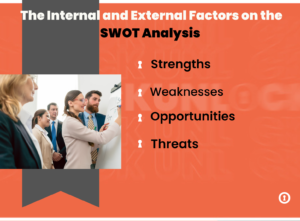Introduction
The daily grind of running a business requires you to make difficult decisions. While some decisions pay off, others turn out to be costly blunders. We would encourage you to give the SWOT analysis method a try if you want to develop a decision-making strategy that is completely foolproof.
For years, businesses have relied on the SWOT analysis to assess the internal and external obstacles to their expansion and develop a strategy.
In this blog post, we will teach you everything you need to know about the SWOT analysis method, what it is, and how your business can use it to grow and succeed.
A strategic planning technique called a SWOT analysis is mostly used by businesses, but it can also be used by individuals and other organizations to assess their competitive status and develop strategic planning.
SWOT here stands Qualities, Shortcomings, Valuable open doors, and Dangers. As a result, a SWOT analysis is a method for assessing these four aspects of a company.
Albert Humphrey, a management consultant who tried out the SWOT analysis framework at the Stanford Research Institute in the 1960s and 1970s, is credited with creating it.
The SWOT analysis was developed with data from Fortune 500 companies. Organizations continue to use it to test their business, strategy, procedures, new product launch, or business branch.
When it comes to making decisions and planning, a SWOT analysis can be an essential tool because it enables a company to discover previously unnoticed opportunities or threats.
How Does a SWOT Analysis help during work?
Are you considering entering a new market? Do you wish to expand a particular division? Are you launching a new item? You can easily identify opportunities and threats in a given environment by conducting a SWOT analysis, as well as your strengths and weaknesses.
It shouldn’t take more than two hours of brainstorming to conduct a SWOT analysis, which is simple. As a matter of fact, a SWOT examination is similar to leading a meeting to generate new ideas with your group.
Simply gather all of your most important business decision-makers and begin the process. Keep in mind that to get a wide range of perspectives, you need people from different departments. This is essential to the success of your SWOT analysis.
Then, hand over a scratch pad and a pen to every one of the partners. We have a great template for you to use if you want to conduct a SWOT analysis online at the end of this blog post!
Also Read: https://www.amazon.in/SWOT-Analysis-Strength-Weaknesses-Opportunities/dp/1449546757
The Effects of the Internal and External Factors on the SWOT Analysis
If the team is having trouble coming up with ideas for each section, it can be helpful to divide the four SWOT elements into two subgroups: Both internal and external factors
An organization’s strengths and weaknesses are internal factors because they are under your organization’s, team’s, or department’s control. Opportunities and threats, on the other hand, are regarded as external factors because the business has no control over them (because they come from the market, the competition, or the economy).
You don’t have to subcategorize the SWOT components to direct a SWOT examination effectively. Notwithstanding, it’s useful to do so assuming that the colleagues are experiencing difficulty perceiving which thought has a place with which quadrant.
Let’s take a closer look at each quadrant and think about the questions you might want to ask as part of your analysis.
Strengths
Your organization’s strengths can be found in the first quadrant. These are the aspects of your business that set it apart from its rivals or that it excels at.
The advantages your company enjoys over its rivals are its strengths. This could be a unique manufacturing process, exclusive technology, strong brand presence, great leadership, geographical advantages, or any number of other things.
As previously stated, strengths are internal factors under the organization’s control. Finding and including your company’s Unique Selling Proposition (USP) in the Strengths section is a great way to add items.
Keep in mind that items in the Strengths section also include things over which your company clearly has an advantage. For instance, if you run an e-commerce store, a strength is guaranteed one-day delivery, but only if you are the only business in the area or industry that offers that service.
Also Read: https://dtevolve.com/blog/financial-management/
Weaknesses
Weaknesses come next. Because everyone likes to think of themselves as the best in the business, a lot of organizations have trouble coming up with concepts for this one! The truth, on the other hand, will only hurt for a short time but will pay off in the long run. When listing your weaknesses, be sincere and face the consequences!
Your organization’s culture, employees, resources, systems, processes, and so on are all examples of weaknesses.
Employee morale, distractions, issues with the supply chain, cashflow, burn rate, and financials are all examples of weaknesses. Make a list of the reasons why your rivals are succeeding more than you are, as well as your areas of weakness.
Opportunities
opportunities can be found in the third quadrant. Opportunities are external factors that, if pursued successfully, have the potential to benefit your organization.
These are possible future developments in your market or industry that will propel your business forward and ensure its success.
The latest technological advancements, favorable government policies, lifestyle trends, potential future contracts and partners, and other possibilities are examples of opportunities for your business.
It’s critical to write down every possible future scenario because even the smallest opening could give you an advantage over your rivals.
Keep in mind that your business will not benefit from simply listing opportunities because you will actually need to put them into action in the future to see any changes or progress that are observable.
Threats
threats are the final section of the matrix. External factors known as threats can hinder your company’s expansion. Changes in the market, the entry of a new competitor, a dry job market, problems with the supply chain, environmental factors, the effects of legislation, and so on are all examples of threats.
The SWOT analysis relies heavily on the identification of threats, which should be done with care. You can only effectively prepare for and confront threats when you are aware of them.
Keep an eye out for new rivals entering the market and their USPs (Unique Selling Propositions). A good way to identify any potential threats and prepare for them in advance is to conduct a competitive analysis.
Also Read: https://en.wikipedia.org/wiki/SWOT_analysis
During a SWOT analysis, questions to ask include:
Before determining points for each quadrant, we have developed some key questions that you or your team could ask to get started with your SWOT analysis. These questions can help you come up with answers for each section and start your SWOT analysis.
Related to Strengths
To find what your assets are as an association, you could begin by posing a portion of the accompanying inquiries:
What is your USP, or one-of-a-kind selling point?
What upper hands do you have over your rivals?
What shows improvement over different organizations in your market or industry?
What essential assets (such as expertise, knowledge, etc.) do you have on your team or company?
What assets do you possess that your rivals do not?
Related to Weaknesses
In a similar vein, one way to begin identifying your organization’s weaknesses is to ask the following questions:
Which business procedures should be improved?
What assets do your rivals possess that you do not?
What do you think your company lacks—leadership, funding, or technology?
Is your company strapped for cash?
Is your company in a bad spot?
What advantages do your rivals offer that you do not?
Related to Opportunities
Identifying opportunities can be challenging, but the following questions will undoubtedly be of assistance:
What opportunities can you take advantage of in your market?
How can we enhance our customer onboarding process or sales funnel?
Are there any resources, technologies, or tools that we aren’t using to their full potential?
Are there any recent market shifts that present an opportunity?
Are there any upcoming events we can use to meet new people and spread word about our brand?
Last but not least, the following are a few questions that you could use to identify potential threats:
Who are your current or likely contenders?
Is there a recent shift in customer behavior that could be detrimental to the company?
Has the cost of raw materials or from suppliers changed significantly?
Is there a forthcoming new technology that has the potential to render our procedures and system obsolete?
Are there any developments in the industry that pose a threat?
Conclusion
When your SWOT analysis is finished, you can use the results to come up with the final plan for growing your business. Take advantage of opportunities and mitigate threats by focusing on your strengths and working on your weaknesses!



















Comments 1